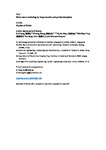Water wave scattering by impermeable and perforated plates
| dc.contributor.author | Liang, H | |
| dc.contributor.author | Zheng, Siming | |
| dc.contributor.author | Shao, Y | |
| dc.contributor.author | Chua, KH | |
| dc.contributor.author | Choo, YS | |
| dc.contributor.author | Greaves, Deborah | |
| dc.date.accessioned | 2021-07-03T09:06:46Z | |
| dc.date.issued | 2021-07-14 | |
| dc.identifier.issn | 1070-6631 | |
| dc.identifier.issn | 1089-7666 | |
| dc.identifier.other | 077111 | |
| dc.identifier.uri | http://hdl.handle.net/10026.1/17301 | |
| dc.description | No embargo required. | |
| dc.description.abstract |
<jats:p>In the field of offshore renewable energy, impermeable plates are used as underwater lenses to amplify the wave amplitude, and perforated plates can harness wave energy as a power takeoff device. Within the framework of the linear potential-flow theory, the water wave scattering by impermeable and perforated horizontal plates is investigated in the present study, and both circular and elliptical plates are considered. The hypersingular integral equation is constructed to model the interaction between water waves and plates of small thickness. For wave scattering by impermeable plates with the focus on wave amplification, wave interference effects due to multiple plates can be utilized to achieve large wave amplification. For perforated plates used for harnessing wave energy, deploying an array of elliptical plates is promising if the deployment line coincides with the major axis and the incident wave propagates along the minor axis. The study gives insight into harnessing energy from water waves by horizontal plates.</jats:p> | |
| dc.format.extent | 077111- | |
| dc.language | en | |
| dc.language.iso | en | |
| dc.publisher | AIP Publishing | |
| dc.subject | 7 Affordable and Clean Energy | |
| dc.subject | 13 Climate Action | |
| dc.title | Water wave scattering by impermeable and perforated plates | |
| dc.type | journal-article | |
| dc.type | Journal Article | |
| plymouth.author-url | https://www.webofscience.com/api/gateway?GWVersion=2&SrcApp=PARTNER_APP&SrcAuth=LinksAMR&KeyUT=WOS:000691875300011&DestLinkType=FullRecord&DestApp=ALL_WOS&UsrCustomerID=11bb513d99f797142bcfeffcc58ea008 | |
| plymouth.issue | 7 | |
| plymouth.volume | 33 | |
| plymouth.publication-status | Published | |
| plymouth.journal | Physics of Fluids | |
| dc.identifier.doi | 10.1063/5.0051355 | |
| plymouth.organisational-group | /Plymouth | |
| plymouth.organisational-group | /Plymouth/Faculty of Science and Engineering | |
| plymouth.organisational-group | /Plymouth/Faculty of Science and Engineering/School of Engineering, Computing and Mathematics | |
| plymouth.organisational-group | /Plymouth/PRIMaRE Publications | |
| plymouth.organisational-group | /Plymouth/REF 2021 Researchers by UoA | |
| plymouth.organisational-group | /Plymouth/REF 2021 Researchers by UoA/UoA12 Engineering | |
| plymouth.organisational-group | /Plymouth/Research Groups | |
| plymouth.organisational-group | /Plymouth/Research Groups/Marine Institute | |
| plymouth.organisational-group | /Plymouth/Users by role | |
| plymouth.organisational-group | /Plymouth/Users by role/Academics | |
| plymouth.organisational-group | /Plymouth/Users by role/Researchers in ResearchFish submission | |
| dcterms.dateAccepted | 2021-06-28 | |
| dc.rights.embargodate | 2021-7-23 | |
| dc.identifier.eissn | 1089-7666 | |
| dc.rights.embargoperiod | Not known | |
| rioxxterms.versionofrecord | 10.1063/5.0051355 | |
| rioxxterms.licenseref.uri | http://www.rioxx.net/licenses/all-rights-reserved | |
| rioxxterms.licenseref.startdate | 2021-07-14 | |
| rioxxterms.type | Journal Article/Review |


